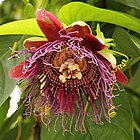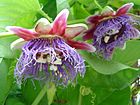Note: This is a project under development. The articles on this wiki are just being initiated and broadly incomplete. You can Help creating new pages.
Difference between revisions of "Passiflora quadrangularis"
(Created page with "{{stub}} ==Uses== {{Uses|}}, {{Uses|}}, {{Uses|}}, {{Uses|}}, {{Uses|}}, {{Uses|}}, {{Uses|}}, {{Uses|}}, {{Uses|}}, {{Uses|}}, {{Uses|}}.<ref name="Uses"/> ==Parts Used== {{...") |
|||
| (5 intermediate revisions by 2 users not shown) | |||
| Line 1: | Line 1: | ||
| − | + | [[File:Passiflora quadrangularis-IMG 4480.jpg|thumb|right|'''Passiflora quadrangularis''']] | |
| + | '''Passiflora quadrangularis''' is a species of plant in the family Passifloraceae. It produces the largest fruit of any species within the genus Passiflora. It is a perennial climber native to the Neotropics. | ||
==Uses== | ==Uses== | ||
| − | {{Uses|}}, {{Uses|}}, {{Uses|}}, {{Uses|}}, {{Uses|}}, {{Uses|}}, {{Uses| | + | {{Uses|Liver problems}}, {{Uses|Headaches}}, {{Uses|Asthma}} , {{Uses|Diarrhea}}, {{Uses|Dysentery}} , {{Uses|Neurasthenia}}, {{Uses|Insomnia}}. |
==Parts Used== | ==Parts Used== | ||
| − | {{Parts Used|}}, {{Parts Used| | + | {{Parts Used|Fruits}}, {{Parts Used|Leaves}}. |
==Chemical Composition== | ==Chemical Composition== | ||
| − | <ref name="chemical composition"/> | + | Quadrangularis were found flavones C,O-diglycosides, saponins (cyclopassifloside derivatives) and cyanogenic glycosides. Two of the flavones C,O-diglycosides found in this hydroethanolic extract.<ref name="chemical composition"/> |
==Common names== | ==Common names== | ||
| − | {{Common names | + | {{Common names|kn=|ml=|sa=|ta=|te=|hi=|en=Giant granadilla, Barbadine}} |
==Properties== | ==Properties== | ||
Reference: Dravya - Substance, Rasa - Taste, Guna - Qualities, Veerya - Potency, Vipaka - Post-digesion effect, Karma - Pharmacological activity, Prabhava - Therepeutics. | Reference: Dravya - Substance, Rasa - Taste, Guna - Qualities, Veerya - Potency, Vipaka - Post-digesion effect, Karma - Pharmacological activity, Prabhava - Therepeutics. | ||
===Dravya=== | ===Dravya=== | ||
| + | |||
===Rasa=== | ===Rasa=== | ||
| − | |||
===Guna=== | ===Guna=== | ||
| Line 29: | Line 30: | ||
==Habit== | ==Habit== | ||
| − | {{Habit|}} | + | {{Habit|Herbs}} |
==Identification== | ==Identification== | ||
===Leaf=== | ===Leaf=== | ||
| − | {{Leaf|||}}<ref name="Leaf"/> | + | {{Leaf|Simple|Round in outline|Alternate; thin, with conspicuous veins sunken on the upper surface, prominent beneath}}<ref name="Leaf"/> |
===Flower=== | ===Flower=== | ||
| − | {{Flower|||| | + | {{Flower|Bisexual|Bell-shaped calyx|Whiteish blue||Up to 4-4.8 inch} |
===Fruit=== | ===Fruit=== | ||
| − | {{Fruit|||| | + | {{Fruit|Simple Fruit|Ovoid|Berry; aromatic; melon-like; delicate skin|Greenish-white/pale- or-deep-yellow|}} |
===Other features=== | ===Other features=== | ||
| Line 46: | Line 47: | ||
==Where to get the saplings== | ==Where to get the saplings== | ||
| − | |||
==Mode of Propagation== | ==Mode of Propagation== | ||
| − | {{Propagation|}} | + | {{Propagation|Seeds}}. |
==How to plant/cultivate== | ==How to plant/cultivate== | ||
| − | <ref name="How to plant/cultivate"/> | + | In commercial plantings in Indonesia, the vines are set 6.5 to 10 ft (2-3 m) apart each way. Harm 30 °F (-1.1; kill 28 °F (-2.2 °C).<ref name="How to plant/cultivate"/> |
==Commonly seen growing in areas== | ==Commonly seen growing in areas== | ||
| − | {{Commonly seen| | + | {{Commonly seen|Lowland forest}}. |
==Photo Gallery== | ==Photo Gallery== | ||
<gallery class="left" caption="" widths="140px" heights="140px"> | <gallery class="left" caption="" widths="140px" heights="140px"> | ||
| − | + | File:Passiflora quadrangularis-IMG 4480.jpg | |
| + | File:Starr-150811-0583-Passiflora quadrangularis-fruit forming-Enchanting Floral Gardens of Kula-Maui (25269590186).jpg | ||
| + | File:Passiflora quadrangularis1644531062.jpg | ||
</gallery> | </gallery> | ||
==References== | ==References== | ||
| + | |||
<references> | <references> | ||
| + | <ref name="chemical composition">[https://www.scielo.br/scielo.php?script=sci_arttext&pid=S0102-695X2012000600004#:~:text=quadrangularis%20were%20found%20flavones%20C,were%20also%20found%20in%20P. Chemical composition]</ref> | ||
| − | <ref name=" | + | <ref name="Leaf">[https://www.growables.org/information/TropicalFruit/Granadilla.htm Morphology]</ref> |
| − | |||
| − | |||
| − | <ref name="How to plant/cultivate">[ | + | <ref name="How to plant/cultivate">[https://www.growables.org/information/TropicalFruit/Granadilla.htm Cultivation Details]</ref> |
| − | |||
</references> | </references> | ||
==External Links== | ==External Links== | ||
| − | * [ ] | + | * [https://www.growables.org/information/TropicalFruit/Granadilla.htm Passiflora quadrangularis on growables.org] |
| − | + | ||
| − | + | ||
[[Category:Herbs]] | [[Category:Herbs]] | ||
| + | [[Category:Passifloraceae]] | ||
Latest revision as of 11:32, 29 June 2020
Passiflora quadrangularis is a species of plant in the family Passifloraceae. It produces the largest fruit of any species within the genus Passiflora. It is a perennial climber native to the Neotropics.
Uses
Parts Used
Chemical Composition
Quadrangularis were found flavones C,O-diglycosides, saponins (cyclopassifloside derivatives) and cyanogenic glycosides. Two of the flavones C,O-diglycosides found in this hydroethanolic extract.[1]
Common names
| Language | Common name |
|---|---|
| Kannada | |
| Hindi | |
| Malayalam | |
| Tamil | |
| Telugu | |
| Marathi | NA |
| Gujarathi | NA |
| Punjabi | NA |
| Kashmiri | NA |
| Sanskrit | |
| English | Giant granadilla, Barbadine |
Properties
Reference: Dravya - Substance, Rasa - Taste, Guna - Qualities, Veerya - Potency, Vipaka - Post-digesion effect, Karma - Pharmacological activity, Prabhava - Therepeutics.
Dravya
Rasa
Guna
Veerya
Vipaka
Karma
Prabhava
Habit
Identification
Leaf
| Kind | Shape | Feature |
|---|---|---|
| Simple | Round in outline | Alternate; thin, with conspicuous veins sunken on the upper surface, prominent beneath |
Flower
{{Flower|Bisexual|Bell-shaped calyx|Whiteish blue||Up to 4-4.8 inch}
Fruit
| Type | Size | Mass | Appearance | Seeds | More information |
|---|---|---|---|---|---|
| Simple Fruit | Ovoid | Berry; aromatic; melon-like; delicate skin | Greenish-white/pale- or-deep-yellow | {{{6}}} |
Other features
List of Ayurvedic medicine in which the herb is used
Where to get the saplings
Mode of Propagation
How to plant/cultivate
In commercial plantings in Indonesia, the vines are set 6.5 to 10 ft (2-3 m) apart each way. Harm 30 °F (-1.1; kill 28 °F (-2.2 °C).[3]
Commonly seen growing in areas
Photo Gallery
References
External Links
- Ayurvedic Herbs known to be helpful to treat Liver problems
- Ayurvedic Herbs known to be helpful to treat Headaches
- Ayurvedic Herbs known to be helpful to treat Asthma
- Ayurvedic Herbs known to be helpful to treat Diarrhea
- Ayurvedic Herbs known to be helpful to treat Dysentery
- Ayurvedic Herbs known to be helpful to treat Neurasthenia
- Ayurvedic Herbs known to be helpful to treat Insomnia
- Herbs with Fruits used in medicine
- Herbs with Leaves used in medicine
- Herbs with common name in English
- Habit - Herbs
- Index of Plants which can be propagated by Seeds
- Herbs that are commonly seen in the region of Lowland forest
- Herbs
- Passifloraceae



